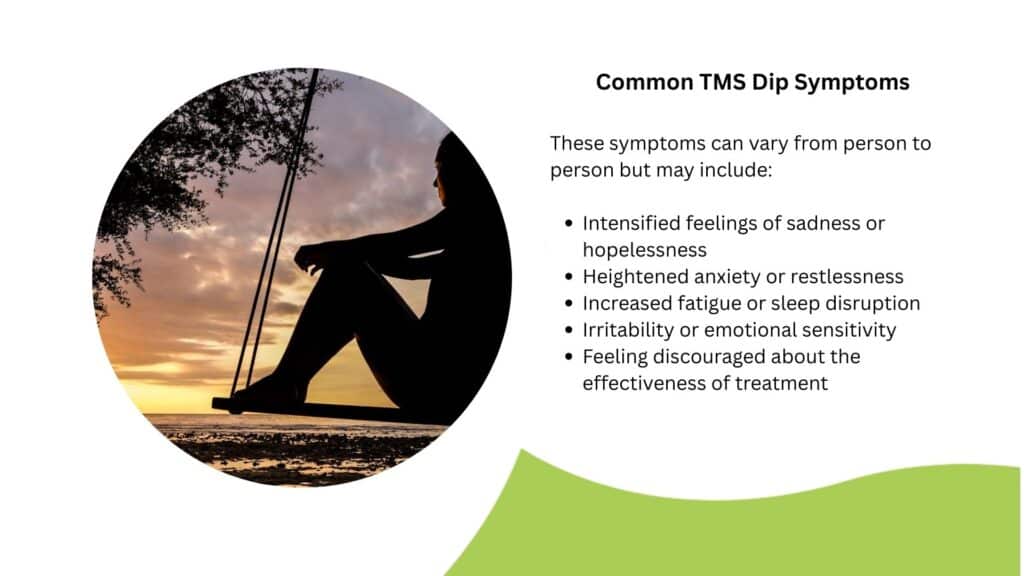
If you’ve recently started Transcranial Magnetic Stimulation (TMS) therapy and feel like your depression symptoms are getting worse before they get better, you’re not alone. This temporary period of increased emotional distress is sometimes referred to as a TMS dip. While it can feel discouraging, it’s usually a short-term response and doesn’t mean the treatment isn’t working.
Understanding why the TMS dip happens and what to expect can help you stay hopeful and on track.
What Is a TMS Dip?
A TMS dip is a period during the early stages of treatment where some people experience a brief worsening of depression, anxiety, or other emotional symptoms. It may feel like your mood is lower, your energy is even more depleted, or your usual coping strategies aren’t helping as much.
Not everyone experiences a dip, but when it does occur, it’s often within the first two to three weeks of treatment.
Common TMS Dip Symptoms
These symptoms can vary from person to person but may include:
- Intensified feelings of sadness or hopelessness
- Heightened anxiety or restlessness
- Increased fatigue or sleep disruption
- Irritability or emotional sensitivity
- Feeling discouraged about the effectiveness of treatment
It’s important to note that these changes are typically temporary and often followed by a noticeable improvement as the treatment progresses.
Why Does a TMS Dip Happen?
While the exact cause of the TMS dip isn’t fully understood, experts believe it may be part of the brain’s adjustment process. TMS works by stimulating the prefrontal cortex, a brain region involved in mood regulation. As this area becomes more active, it may temporarily disrupt emotional balance before stabilizing into a healthier pattern.
This is somewhat similar to how some people feel worse before they feel better when starting antidepressant medication. It’s a sign that the brain is responding—even if the process feels uncomfortable at first.
How Long Does the TMS Dip Last?
For most people, TMS dip symptoms last anywhere from a few days to two weeks. Once past this phase, many begin to experience improvements in mood, focus, and energy. Keeping open communication with your provider during this time is essential—they can offer reassurance, track your progress, and adjust your treatment plan if needed.
How to Cope With a TMS Dip
If you’re experiencing a dip during TMS, here are a few things that can help:
- Stay the course: It can be tempting to stop treatment if you feel worse, but most dips are temporary. Completing the full course is key to seeing lasting results.
- Talk to your provider: They can help assess whether your symptoms are part of the typical adjustment process or if something else may be going on.
- Lean on support: Reach out to friends, family, or a therapist. Having a support system makes the experience more manageable.
- Practice self-care: Gentle exercise, good nutrition, rest, and calming routines can help ease stress during this period.
- Track your symptoms: Keeping a journal can help you and your provider identify patterns and improvements over time.
TMS Offers Hope—even Through the Dip
Even if things feel harder before they get better, that doesn’t mean the treatment is failing. Many people who experience a dip go on to report meaningful improvement in their depression symptoms. TMS therapy is designed to work gradually and restore balance in the brain over time.
If you’re feeling uncertain or discouraged during treatment, know that you’re not alone—and that what you’re experiencing may be part of the healing process.

FAQs About TMS Dip Symptoms
Is it normal to feel worse before feeling better with TMS?
Yes, some patients experience a temporary increase in symptoms early in treatment, known as a TMS dip. This usually improves as therapy continues.
When does the TMS dip usually start?
Most people who experience a dip notice it within the first 1–3 weeks of starting TMS therapy.
Does a TMS dip mean the treatment isn’t working?
No. A dip doesn’t mean failure—it often indicates that your brain is responding and adjusting to the stimulation.
What should I do if I feel worse during TMS?
Speak with your provider. They can offer guidance, reassurance, or adjust the treatment schedule if needed.
How long does a TMS dip last?
Dips typically last a few days to two weeks. Most patients begin to notice improvement after this period.
Can I continue daily activities during a TMS dip?
Yes, though you might feel more fatigued or emotionally sensitive. Listening to your body and prioritizing rest can help.
Will everyone experience a TMS dip?
No, not everyone goes through a dip. Some people begin feeling better right away, while others improve gradually without a noticeable dip.
Schedule Your Complimentary TMS Screening Today
At My TMS Therapy, we’re here to help you restore your energy and joy. Our compassionate team will guide you through every step of the process.
Call us at (877) 548-8081 or contact us online to book your screening today.
Sources:
Cognitive FX. What Patients Should Know About the TMS Dip https://www.cognitivefxusa.com/blog/what-to-know-about-the-tms-dip/
Madison Ave TMS. The TMS Dip: What Is It and How Long Does It Last? https://www.madisonavetms.com/blog/what-is-the-tms-dip-what-should-i-do-if-im-experiencing-a-dip/
American TMS Clinics. The TMS Dip: Is It Real? How Long Will It Last? https://www.americantmsclinics.com/the-tms-dip-is-it-real-how-long-will-it-last/
Resiliency Mind + Body Medicine. What is the TMS Treatment “Dip”? Strategies for Wellness and Healing. https://resiliencymbmedicine.com/blog/tms-treatment-dip/



